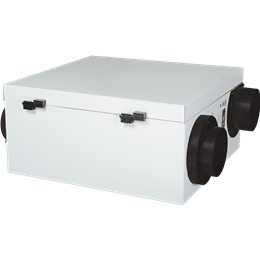An Energy Recovery Ventilator (ERV) is a crucial component in modern ventilation systems. Ventilation has long been a standard and a requirement for commercial buildings. Decades ago, the American Society of Heating, Refrigeration, and Air-conditioning Engineers (ASHRAE) began setting the standards for the quantity of fresh air that must be brought into an occupied space from outside. Over time the quantities have changed in order to balance Indoor Air Quality (IAQ) with energy efficiency: More outside air coming in is good for occupant health but in order to maintain building pressurization that also means more conditioned air going out. Conditioning that air in the first place is often one of the highest energy costs in a building and just letting it go is a big waste of used energy. This is where the first two terms in the ERV name come into play, Energy Recovery. To understand how this energy can be recovered, let’s dive into the key features and options available in an ERV.
Recovering Energy
Air in buildings has two main properties that occupants, owners, and engineers care about: Temperature and Humidity. These two properties require energy input to control in the form of refrigeration cycle motors and fans and sometimes humidifiers and pumps. The desired levels of thermal energy (temperature) and water vapor (humidity) in the air therefore represent an energy investment that would be a waste to simply exhaust out of the building. Here the ERV steps in to provide a path and a medium for the outgoing airstream and the incoming airstream to transfer their thermal energy and water vapor to each other! This transfer happens naturally – from high to low temperature/humidity – and the two airstreams will reach the same temperature and humidity if given enough time in contact, though complete equilibrium is not practical. Both directions of transfer are advantageous, but in the climate of Washington, we are mainly concerned with warming incoming cold winter air.
- Heat Recovery: Temperature transfer between the inside and outside air is accomplished by running each airstream over either side of a common physical medium, typically a polymer material. The thermal energy transferred here and in general is also known as sensible energy or sensible heat.
- Humidity Recovery: Humidity transfer is dependent on the type of ERV and there are two methods: through use of materials known as desiccants or with heat transfer mediums that are also moisture permeable. Desiccant materials attract water vapor from the more humid air and that water can then be picked up by the drier air. Water vapor’s presence in air is measurable by the latent energy it brings to the air-water mixture. This is because it takes a certain amount of energy or heat to add to or remove gaseous water from air. The moisture recovery process is then commonly referred to as the transfer of latent heat.
HRV vs. ERV
You’ve likely seen both of these acronyms used to describe a machine that appears to do the same thing. While both Heat Recovery Ventilators (HRVs) and ERVs are ventilators that recover energy in similar ways, the difference is all about what types of energy are recovered:
- HRVs Transfer only heat or sensible energy and not humidity and are sometimes referred to as sensible-only devices. Sensible effectiveness refers to an HRV or ERV’s ability to transmit only thermal energy.
- ERVs Transfer both temperature and moisture, sensible and latent energy. The energy in energy recovery refers to that total composed of sensible and latent. Total effectiveness then refers to a device’s performance in transferring both heat and moisture.

Energy recovery ventilation devices are a versatile and effective solution to energy savings for ventilation air at the intersection of enhanced indoor air quality, energy efficiency, and temperature and humidity control. As occupant awareness continues to rise and building and energy codes develop, the specification of ERVs is becoming integral to creating healthy, sustainable, and comfortable indoor environments.
